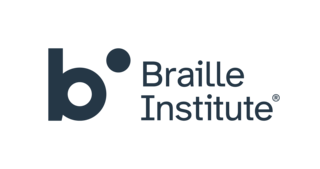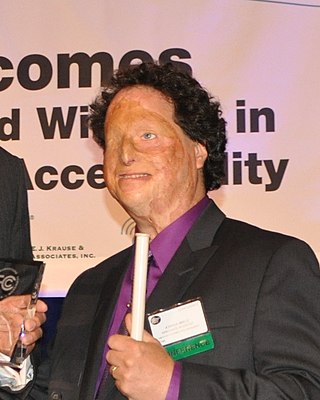Related Research Articles

Braille is a tactile writing system used by people who are visually impaired. It can be read either on embossed paper or by using refreshable braille displays that connect to computers and smartphone devices. Braille can be written using a slate and stylus, a braille writer, an electronic braille notetaker or with the use of a computer connected to a braille embosser.
Perkins School for the Blind, in Watertown, Massachusetts, was founded in 1829 and is the oldest school for the blind in the United States. It has also been known as the Perkins Institution for the Blind.
Service and supports for people with disabilities are those government or other institutional services and supports specifically provided to enable people who have disabilities to participate in society and community life. Some such services and supports are mandated or required by law, some are assisted by technologies that have made it easier to provide the service or support while others are commercially available not only to persons with disabilities, but to everyone who might make use of them.

Visual or vision impairment is the partial or total inability of visual perception. In the absence of treatment such as corrective eyewear, assistive devices, and medical treatment – visual impairment may cause the individual difficulties with normal daily tasks including reading and walking. The terms low vision and blindness are often used for levels of impairment which are difficult or impossible to correct and significantly impact daily life. In addition to the various permanent conditions, fleeting temporary vision impairment, amaurosis fugax, may occur, and may indicate serious medical problems.

The CNIB Foundation is a Canadian charitable organization and volunteer agency dedicated to assisting Canadians who are blind or living with vision loss, and to provide information about vision health for all Canadians. Founded in 1918 as the Canadian National Institute for the Blind to assist soldiers who had been blinded in the First World War, CNIB originally offered sheltered care and specialized employment to people with vision loss. It has since expanded to include other programs and services, including research, public education, rehabilitation counselling and training, advocacy and an alternative-format library for people living with a print disability. It is a member of the Braille Authority of North America.
The Catalan Association for the Blind and Visually Impaired, with headquarters in Barcelona, is a non-profit organization, registered in the Registre d'Associacions de la Conselleria de Justícia de la Generalitat de Catalunya with the number 14,965 and declared of Public Utility by the Ministerio del Interior on December 29, 1997.
Braille technology is assistive technology which allows blind or visually impaired people to read, write, or manipulate braille electronically. This technology allows users to do common tasks such as writing, browsing the Internet, typing in Braille and printing in text, engaging in chat, downloading files and music, using electronic mail, burning music, and reading documents. It also allows blind or visually impaired students to complete all assignments in school as the rest of their sighted classmates and allows them to take courses online. It enables professionals to do their jobs and teachers to lecture using hardware and software applications. The advances in Braille technology are meaningful because blind people can access more texts, books, and libraries, and it also facilitates the printing of Braille texts.

The Associated Services for the Blind & Visually Impaired (ASB) is a private non-profit organization in Philadelphia, Pennsylvania. It assists those living with vision loss to achieve independence through education, support services to advance necessary skills, and community connections. ASB collaborates with local, regional and national partners to provide additional resources and opportunities to clients.
Telesensory Systems, Inc. (TSI) was an American corporation that invented, designed, manufactured, and distributed technological aids for blind and low vision persons. TSI's products helped visually impaired people work independently with computers and with ordinary printed materials.

The American Printing House for the Blind (APH) is an American non-for-profit corporation in Louisville, Kentucky, promoting independent living for people who are blind and visually impaired. For over 150 years APH has created unique products and services to support all aspects of daily life without sight.
A sighted child who is reading at a basic level should be able to understand common words and answer simple questions about the information presented. They should also have enough fluency to get through the material in a timely manner. Over the course of a child's education, these foundations are built on to teach higher levels of math, science, and comprehension skills. Children who are blind not only have the education disadvantage of not being able to see: they also miss out on the very fundamental parts of early and advanced education if not provided with the necessary tools.

The Braille Institute of America (BIA) is a nonprofit organization with headquarters in Los Angeles providing programs, seminars and one-on-one instruction for the visually impaired community in Southern California. Funded almost entirely by private donations, all of the institute's services are provided completely free of charge. The organization has seven regional centers: Anaheim, Coachella Valley, Laguna Hills, Los Angeles, Riverside, San Diego and Santa Barbara, as well as outreach programs at more than 200 locations throughout Southern California. It is a member of the Braille Authority of North America.
The Cleveland Sight Center (CSC) is a non-profit organization that provides services to individuals who are blind or visually impaired. Founded in 1906, it is accredited by the Commission on Accreditation of Rehabilitation Facilities (CARF) and serves around 10,000 clients annually in Northeast Ohio. The organization also has radio-reading and community outreach programs that benefit a larger number of individuals.
A print-disabled person is "a person who cannot effectively read print because of a visual, physical, perceptual, developmental, cognitive, or learning disability". A print disability prevents a person from gaining information from printed material in the standard way, and requires them to utilize alternative methods to access that information. Print disabilities include visual impairments, learning disabilities, or physical disabilities that impede the ability to manipulate a book. The term was coined by George Kerscher, a pioneer in digital talking books. DAISY is used by libraries as a means of making complex books accessible via audio.
OrCam devices such as OrCam MyEye are portable, artificial vision devices that allow visually impaired people to understand text and identify objects through audio feedback, describing what they are unable to see.
Father Thomas J. Carroll was a Catholic priest and a pioneer in treatment for people who became blind later in their lives,. He was also a leader in implementing liturgical renewal in the Catholic church after Vatican II and took an active part in the civil rights movement.

Jyothirgamaya Foundation is a nonprofit organization, based in Thiruvananthapuram Kerala which is actively involved in the empowerment of persons with visual impairment founded in 2015 by Tiffany Brar. The project started as a mobile blind school in 2012. Tiffany Brar herself, traveled through rural areas in public transport in search of blind people of all ages in rural areas in India, with the aim of bringing out of the four walls of their house, to which they are confined, and brings a new light to their eyes, which has nothing to do with their eyesight. Jyothirgamaya Foundation holds Special consultative status with United Nations.

Joshua A. Miele is an American research scientist who specializes in accessible technology design. Since 2019, Miele has been Principal Accessibility Researcher at Amazon Lab126, a subsidiary of Amazon that works on hardware products. Miele previously conducted research on tactile graphics and auditory displays at the Smith-Kettlewell Eye Research Institute in California for fifteen years. He has been blind since early childhood.
Anindya Bapin Bhattacharyya is an Indian American technology instructor for the deafblind. He coordinates the National Outreach Technology Development and Training Program at the Helen Keller National Center for DeafBlind Youths and Adults, traveling the country teaching deafblind people to use adaptive technology. Deaf from birth and blind at the age of nine, Bhattacharyya has been an advocate for deafblind individuals in the United States and beyond.
Judy Castle Scott is an advocate and activist known for her work to improve the living conditions of the visually impaired. Blind herself, she worked for several public and private organizations dedicated to the cause, and served as the director of the American Foundation for the Blind, retiring in 2015. Over the course of her career, Scott has been the recipient of various accolades, including being inducted into the Texas Women's Hall of Fame.
References
- ↑ Montague, Adrianna (2006). "Kirk Adams is next AFB President and CEO". AFB.org (Press release). American Foundation for the Blind. Retrieved January 10, 2017.
- 1 2 Koestler, Frances A. (2004). The Unseen Minority: A Social History of Blindness in the United States (2nd ed.). New York: AFB Press.
- ↑ American Foundation for the Blind; Rand, Lotta S. (1926). Agencies for the blind in America. Directory of activities for the blind in the United States and Canada. Directory of activities for the blind. New York: American foundation for the blind, inc.
- ↑ "Milestones in AFB's History". AFB.org. American Foundation for the Blind. 2020.
- ↑ "The Helen Keller Archive". The American Foundation for the Blind. 2020.
- ↑ Vision Problems in the U.S.: Prevalence of Adult Vision Impairment and Age-Related Eye Disease in America (Update to the 4th ed.). Schaumburg, Illinois: Prevent Blindness America. 2008.
- ↑ "About FamilyConnect". FamilyConnect.org. American Foundation for the Blind. Retrieved 9 January 2016.